In May 2025, EuroClio and Europeana welcomed six cultural heritage educators to The Hague for a co-creation session as part of ‘Creating Lessons with Cultural Heritage’. The project seeks to dive into the untapped wealth of cultural heritage available through museums, archives and other cultural institutions to create ready-to-use materials for the classroom.
During their stay, the educators co-created eLearning activities using the Historiana platform. Below, Dr Konstantinos Oikonomou, Secondary Education teacher of Greek and History and Education Consultant of Humanistic subjects for the Greek Ministry of Education, shares his experience of working with digital cultural heritage and introduces his eLearning teaching activity.
- Link to the eLearning activity: http://hi.st/BrS
Why is it important to work with cultural heritage?
Working with cultural heritage sources in the history classroom enables students to engage with the past in both tangible and critical ways. These sources include photographs, posters, pamphlets, maps, official documents, personal letters, diaries, cartoons, oral testimonies, artifacts, and even everyday objects or built heritage, such as monuments and buildings; they also include newspapers and relevant materials like weekly or monthly reviews, etc. All these materials, both written and not written, carry the voice, the mood, and the values of the time in which they were produced. By encountering these materials/historical objects, students are invited to think like historians: to interpret traces of the past, question their reliability, understand their context, and develop empathy with people from different times and places.
With the advances of technology today, all these historical materials, which formerly were very hard to access (as they were found only in archives, museums, tangible collections etc.), can be very easily accessed in their digitized form (mainly with photos and videos, which were and still are primary sources themselves, but now, as digital material, “transmit” other tangible and even intangible elements). The only condition for this is that they be digitized.
With these thoughts in mind, we created an eLearning activity in which we suggest the use of digitized historical newspapers. This eLearning activity is the object of this blog.
The use of digitized historical newspapers brings a unique opportunity to explore many historical events, like for example the National Schism in Greece (which is the theme of our activity), not just as a political narrative from the top down, but as a lived reality that unfolded daily in the press. These newspapers, often overlooked in classroom settings, offer a wealth of information: editorial positions, language and tone, omissions and silences, and snapshots of public opinion, fear, and hope.
Digitized cultural heritage is, therefore, democratizing. Working with newspapers, for example, was laborious in the past: teachers had to travel to archives, search through microfilm, and reproduce poor-quality copies. Today, the material is searchable, accessible, and ready to be integrated into digital learning environments like Historiana. This accessibility opens new paths for inquiry-based, source-driven historical learning that connects local archives to European and global contexts.
General principles and teaching strategies
The teaching approach developed for the eLearning activity “The Greek National Schism (1914-1917) in the Press: A Historical Inquiry with Newspapers” is generally rooted in the use of primary sources and historical inquiry, with an emphasis on the affordances of digitized cultural heritage.
Regarding the use of the historical sources, it draws from general principles laid out, for example, in the “Teacher’s Guide: Working with Sources in History Education” published by EuroClio (aiming to address four key dimensions of source work: reading, contextualizing, questioning, and corroborating).
The kind of source that it uses is the newspaper, particularly in the digitized version. Newspapers are just one of many types of primary sources available for use in history education. In this case, they were chosen by the author of the activity because the historical period under discussion coincides with the widespread circulation of newspapers.
Regarding the content, the activity is built around a pivotal moment in modern Greek history: the beginning of the National Schism marked by Eleftherios Venizelos’s resignation in February 1915. This historical event, with major consequences in the following decades (sometimes felt even today), refers to the wide division formed in Greece’s political life after the beginning of the First World War (1914): King Constanine I advocated for neutrality (which, however, meant supporting Germany), while the elected Prime Minister Venizelos pursued the aims of the Entente. The schism lasted officially until 1917, when Greece entered the war, but then led to the Asia Minor Catastrophe (1922).

Students are invited to explore a digitized newspaper (“Simaia”, from 22 February 1915, found here. The following general framework of questions can be dealt with:
- What kind of narrative does the newspaper present?
- How is the event framed linguistically and visually?
- What is emphasized and what is left unsaid?
- How does this source compare to the official school textbook?
Generally, the strategy involves structured source analysis with guiding questions, visual and textual decoding, and reflection tasks that ask students to consider how newspapers shape historical memory.
This student engagement is facilitated by tools embedded in Historiana, while flexibility is allowed for – students can work individually, in pairs, or in groups, and teachers can adapt it for different durations or educational levels.
The activity -and every activity following its spirit- corresponds to at least 2 of the Six Big Thinking Skills (=”use of evidence” and “historical perspective”) of Seixas and Morton’s Model for Historical Thinking and is, generally, aligned with Euroclio’s Manifesto for teaching history (available on its website). Further, it doesn’t neglect aspects of van Boxtel and van Drie’s Historical Thinking Model (Van Boxtel, C., & Van Drie, J. (2018). Historical Reasoning: Conceptualizations and Educational Applications. In S. A. Metzger & L. M. Harris (Eds.), International Handbook of History Teaching and Learning.: Wiley & Blackwell), while also echoing the “essentials for high-quality history education” presented in Euroclio’s “Historiana – Teacher Training Guide” (pp. 6-7, available on Historiana’s website).
As already pointed out, the use of digitized historical newspapers is particularly significant today because such materials are now more accessible than ever through digital repositories. While using newspapers as sources in history classrooms is not in itself a novel idea, the activity builds on the notion that the educational value of newspapers mirrors their relevance in historical scholarship (see, for example, Allen & Sieczkiewicz, How Historians use Historical Newspapers, in Proceedings of the American Society for Information Science and Technology, November 2010, whose insights helped shape the pedagogical design of this lesson).
But until recently, practical barriers made working with such sources difficult — teachers would have needed to access physical archives and produce photocopies. Now, digitization has opened new possibilities. In Greece, as in many other countries, all major newspapers published since the foundation of the modern state are preserved in dedicated repositories — for example, the Library of the Hellenic Parliament (https://digitallibrary.parliament.gr/). Comparable examples include the U.S. (Chronicling America), France (Gallica), the U.K. (British Newspaper Archive), and the Netherlands (Delpher).
For this activity, we chose to work specifically with material found on Europeana, the European digital platform for cultural heritage. We were pleased to discover a rich selection of digitized Greek newspapers that allowed us to design this educational resource around freely available, authentic historical content.
The example eLearning activity
As we said, the activity focuses on the National Schism in Greece, a major historical event in modern Greek history, and invites students to engage with a primary source — a historical newspaper — to enrich and critically expand their understanding of this event beyond the school textbook narrative.
The activity is divided into manageable steps: introductory reading, source observation, guided analysis, reflection, and comparison with the textbook, and a synthesis exercise.
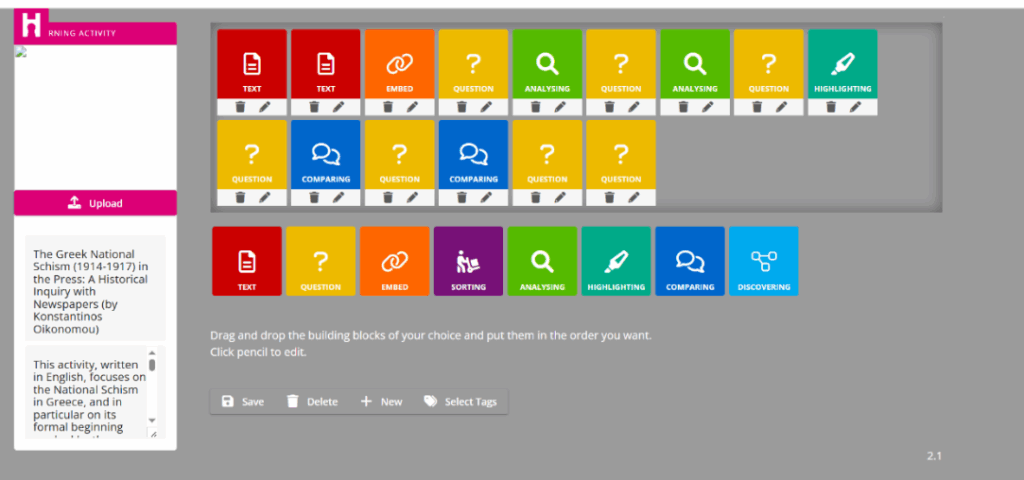
All the parts of the activity are facilitated in their creation by the corresponding tools of Historiana (the so-called blocks of the e-builder). This means that Historiana and its activity builder foresee all the necessary steps of a historical enquiry (as this is prescribed by various historical thinking models): analyzing, comparing, synthesizing; and even annotating or highlighting on the sources.
Following the design, our activity begins with an accessible textbook narrative of the event and contrasts it with a newspaper (an issue of it) as a real-time press source.
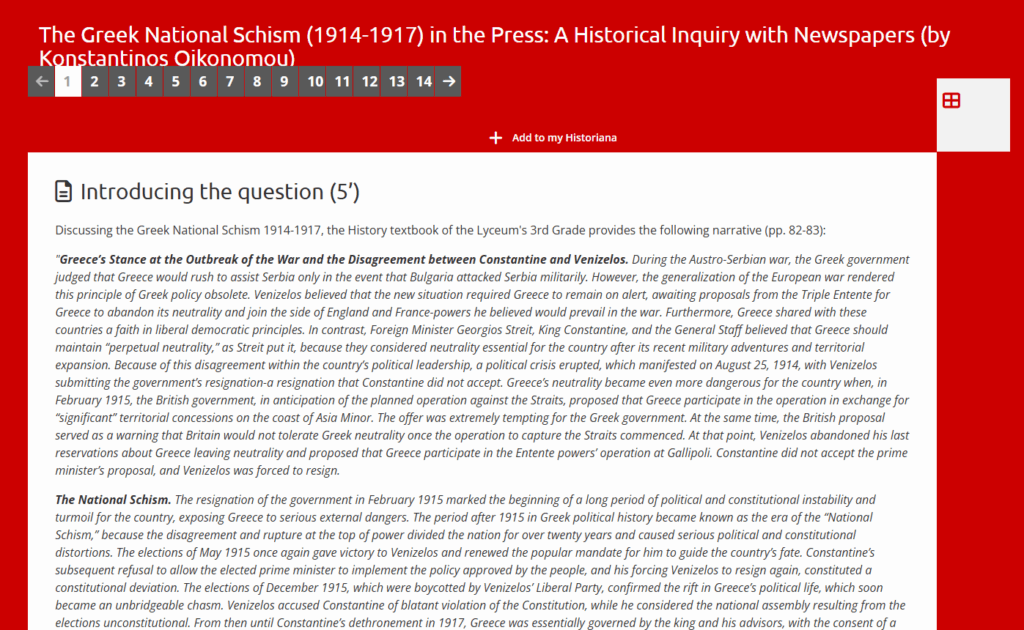
Next comes a task allowing for a general approach to the newspapers (as a generic type of source).
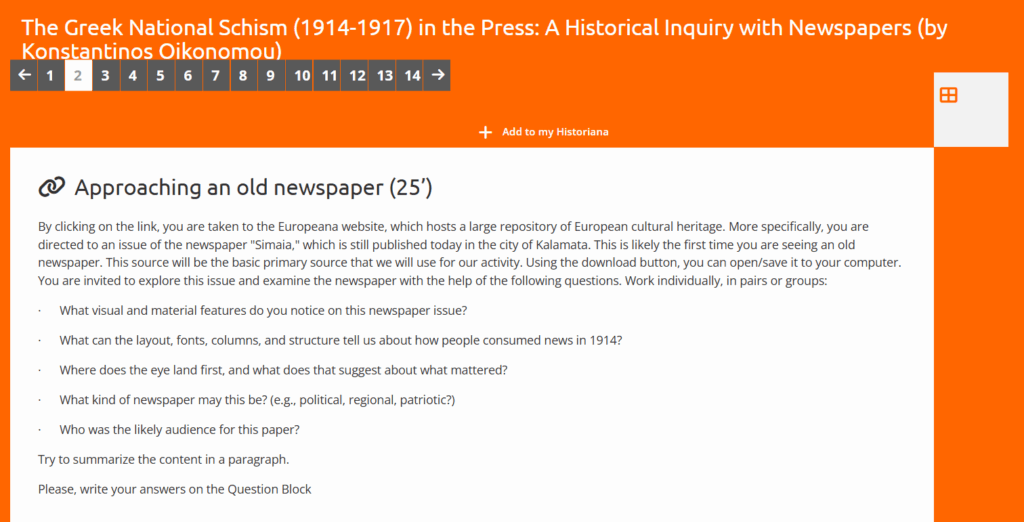
The activity continues with other sub-activities like analysis of editorials, telegrams (that were usual for that time) etc.
There is the option for the students to answer any question either on paper or online (in the second case, their answers can be sent to the teacher).
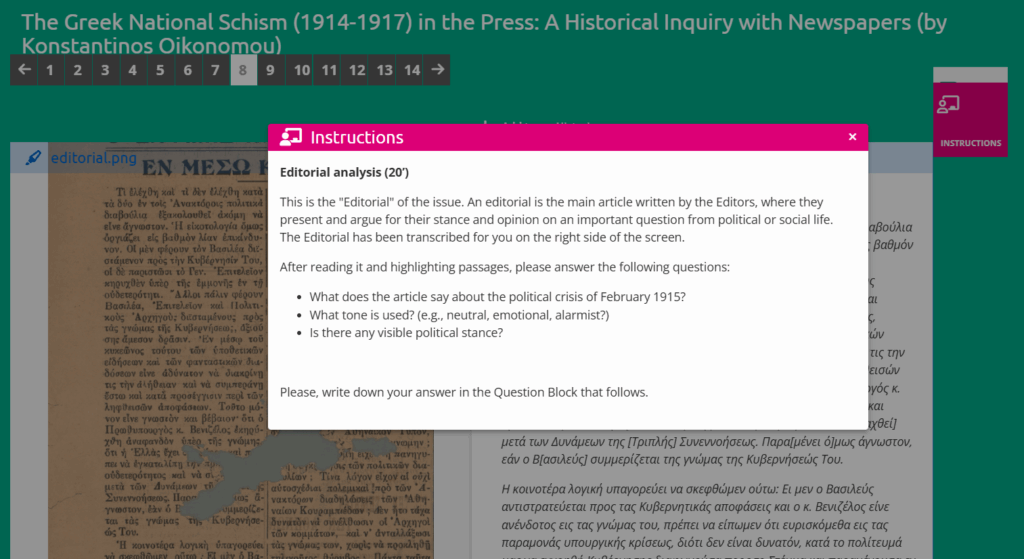
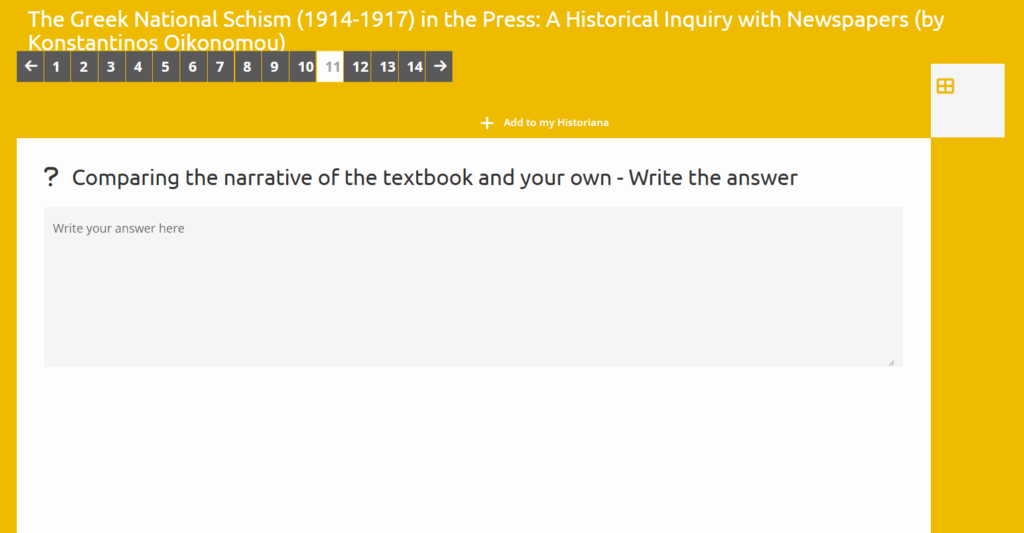
Students may also compare, analyze, sort materials, etc. A very large number of sources and materials can be used.
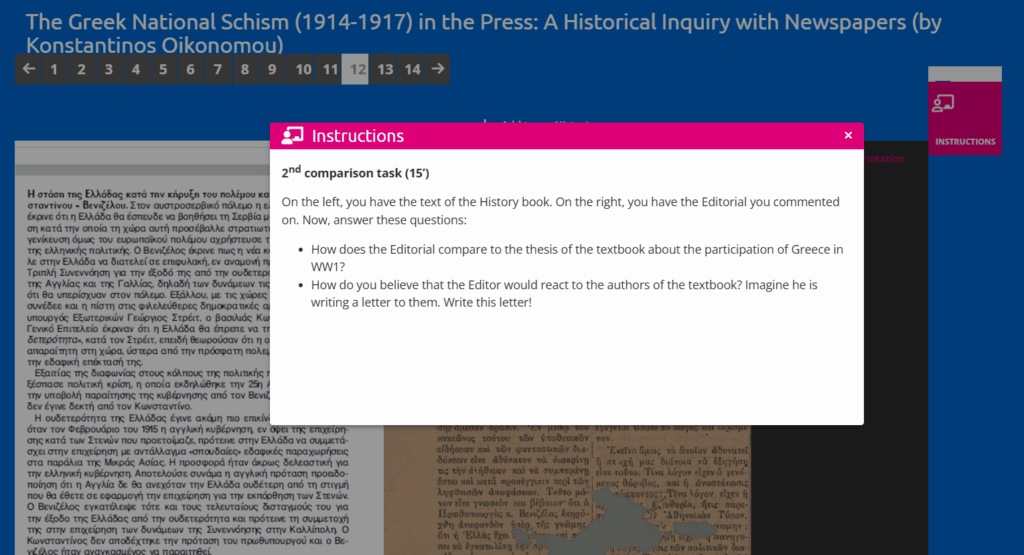
Conclusion
The e-activity that we described in this blog focuses on the National Schism in Greece, asking students to engage with a historical newspaper to critically expand their understanding of this event (beyond the school textbook narrative).
Although this particular example focuses on a Greek historical topic, the template is fully transferable. It can be adapted to other national contexts, events, or periods where digitized press material is available.
Ultimately, the goal is to empower students to become more critical and independent users of historical sources, while also appreciating the value of cultural heritage archives as living, dynamic resources for education.